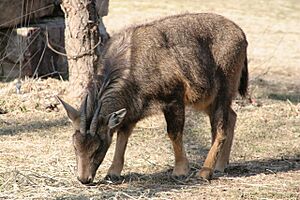Long-tailed goral facts for kids
Quick facts for kids Long-tailed goral |
|
|---|---|
 |
|
| Long-tailed goral at Saint Louis Zoo | |
| Conservation status | |
| Scientific classification | |
| Genus: |
Naemorhedus
|
| Species: |
caudatus
|
 |
|
| Naemorhedus caudatus range | |
The long-tailed goral (also called the Amur goral) is a type of wild goat-like animal. Its scientific name is Naemorhedus caudatus. You can find these amazing creatures living in the mountains of eastern and northern Asia. This includes countries like Russia, China, and Korea.
A small group of long-tailed gorals lives in the Korean Demilitarized Zone. In South Korea, this animal is considered endangered, with fewer than 250 left. It's even a special South Korean natural monument! Some gorals were also seen in northeast India in 2003.
Contents
Where Long-tailed Gorals Live
The long-tailed goral lives in the wild across parts of China, Russia, and Korea, and even in the Himalayas. Today, the biggest group in the wild, about 600 gorals, lives in Russia, but their numbers are going down. In other places, there are usually fewer than 200 gorals.
Many long-tailed gorals also live in zoos around the world. This helps people learn about them and helps protect the species. Some zoos that have them include The Wilds of Ohio, Saint Louis Zoo, and Minnesota Zoo.
Caring for Gorals in Zoos
In the past, some gorals in zoos faced health problems. For example, in the 1970s and 1980s, some gorals in zoos in India and Pakistan got sick. Scientists found that these gorals had different health issues, like problems caused by tiny worms or lung infections. This taught zoos a lot about how to keep gorals healthy and safe.
What Their Home is Like
Long-tailed gorals love to live in high, rocky mountains. They prefer places that are dry, steep, and have lots of cliffs. They often make their homes near cliffs with small cracks where they can hide from danger. These areas might have some evergreen or leafy trees. Sometimes, you can spot gorals eating grass on open, grassy ridges.
Goral Groups and Their Homes
Gorals are social animals and usually live in groups. These groups can have anywhere from two to 12 gorals. A group usually includes females, their young (called kids), and younger males. Older males often prefer to live by themselves.
How Far They Travel
Goral groups usually stay within a home area of about 100 acres. However, male gorals might travel much farther when it's mating season. They will go over rough mountains to find as many females as possible.
What Long-tailed Gorals Look Like
Long-tailed gorals look a lot like goats! Male gorals can weigh between 62 and 93 pounds, while females are a bit lighter, weighing 49 to 77 pounds. They can be from 32 to 51 inches long and stand 20 to 31 inches tall at the shoulder.
They are part of the goat-antelope family. Their horns curve backward and have clear rings on them. They also have small openings between their hooves. A goral's face is flat, and its nose and eyes are very close together. Their fur is brown with shades of gray, and the outer fur is long. Their bushy tail is usually dark brown or black. Female gorals are often lighter in color than males, and their horns are smaller.
What Long-tailed Gorals Eat
Gorals are "browsers," which means they eat a wide variety of plants. They munch on grasses, woody twigs, leaves, and even nuts and fruits. In the summer, they mostly eat the many grasses that grow on the mountains. In winter, they switch to eating woody twigs and leaves from trees and bushes. They have also been known to eat acorns and some types of fruit.
Life Cycle and Reproduction
In the wild, a goral usually lives for 10 to 15 years. However, one goral in a zoo lived to be 17 years old!
Female gorals are ready to have babies once a year. They can be fertilized by a male during a special time that lasts about 30 to 40 hours. After about 215 days (which is their pregnancy period), they usually give birth to one baby, or very rarely, twins. Zoos have been quite successful in helping gorals have babies, especially the San Diego Zoo.
Protecting Long-tailed Gorals
The long-tailed goral is a protected animal. Many special areas have been set aside to protect wildlife, and even though gorals might not be the main focus, they are safe when they are in these places. In China, the long-tailed goral is a protected species. However, it's hard to enforce these rules because some people hunt them for their fur, meat, horns, and for use in traditional medicine.
One important way to help gorals is by keeping them in zoos. This helps make sure the species doesn't disappear. Wild gorals also face threats from natural predators like lynx, snow leopards, tigers, and wolves in some areas.
Another big problem for gorals is that their homes are being destroyed. Farmers use a method called "slash-and-burn" to clear land, which takes away the gorals' natural habitat. Also, farm animals eat all the grass, leaving nothing for the wild gorals. Sadly, gorals are also losing space in zoos because they are not as well-known as animals like tigers or lions. Zoos sometimes choose more popular animals to attract more visitors.
It's tough to stop poaching, especially when people hunt for food. One idea to help is to increase ecotourism. This could bring money to local people, so they wouldn't need to hunt gorals. Gorals in zoos are healthy, so it might be possible to release some back into the wild in the future. The long-tailed goral has been on the endangered species list for a while, and its situation hasn't improved. If their numbers keep going down, the future for the long-tailed goral looks difficult.
See also
- List of mammals of Korea


